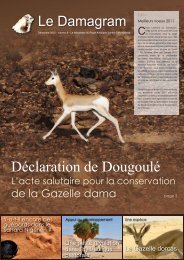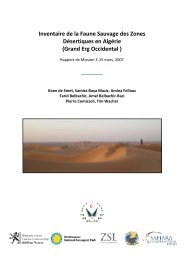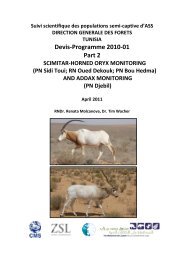The Biology, Husbandry and Conservation Scimitar-horned Oryx ...
The Biology, Husbandry and Conservation Scimitar-horned Oryx ...
The Biology, Husbandry and Conservation Scimitar-horned Oryx ...
You also want an ePaper? Increase the reach of your titles
YUMPU automatically turns print PDFs into web optimized ePapers that Google loves.
18<br />
Part 1: <strong>Biology</strong> & <strong>Conservation</strong><br />
the development of supporting ranch programmes (Rost, 1985), <strong>and</strong> in 1983, the Texas Ranch<br />
Project began (Anon, 1989). <strong>The</strong>re are now several ranches in Texas with oryx, but the largest<br />
herd is held at the Bamberger Ranch near Johnson City, Texas (J.Baccus, pers. comm.).<br />
<strong>The</strong> Australasian captive breeding programme<br />
<strong>The</strong> Australasian Species Management Program (ASMP) was established by the Australasian<br />
Regional Association of Zoological Parks <strong>and</strong> Aquaria (ARAZPA) in 1993. <strong>The</strong> first animals to<br />
be brought into the region were originally shipped into New Zeal<strong>and</strong> from Marwell Zoological<br />
Park (UK) in 1978. <strong>The</strong>se animals bred <strong>and</strong> their offspring were dispersed to institutions in<br />
Australia. Further oryx were imported from Marwell in 1986 <strong>and</strong> 1987. <strong>The</strong> population of<br />
scimitar-<strong>horned</strong> oryx in the Australasian region as of the 30 th June 2002 was 24.47.0 (71) (R<br />
Wilkins, pers comm.).<br />
<strong>The</strong> global overview<br />
In the 1990s, the <strong>Conservation</strong> Breeding Specialist Group (of the IUCN Species Survival<br />
Commission) established that the scimitar-<strong>horned</strong> oryx was the second most commonly found<br />
antelope species in ‘managed’ populations around the world with over 1,200 individuals in<br />
zoological institutions. This figure excluded the oryx held on the Texas ranches which total more<br />
than 2000 animals (Lankard, 2001). Current estimates of the global captive population from the<br />
international studbook put the number of captive oryx at 913.1124.25 (2062). This may be an<br />
overestimate, but it is certain that oryx breed well in captivity <strong>and</strong> readily adapt to captive<br />
conditions (Dixon et al., 1991).<br />
In situ <strong>Conservation</strong> Activities<br />
While scimitar-<strong>horned</strong> oryx continue to rely on responsible ex-situ management, efforts are now<br />
being made to return this species to the wild.<br />
Release projects<br />
A number of projects have been initiated, or proposed, to reintroduce scimitar-<strong>horned</strong> oryx to the<br />
Sahelo-Saharan region. In 1985, Bou Hedma, Tunisia, became the first National Park (NP) to<br />
receive captive oryx for release back into the wild. Since then, projects have been initiated in Sidi<br />
Toui NP, Tunisia; Souss Massa NP, Morocco, <strong>and</strong> the Guembeul Fauna Reserve <strong>and</strong> the Ferlo NP<br />
<strong>and</strong> Biosphere Reserve, Senegal. Wildlife surveys have taken place in Chad <strong>and</strong> Niger to establish<br />
if suitable sites exist for the reintroduction of oryx, <strong>and</strong> other countries have initiated <strong>and</strong><br />
participated in activities to return this species to their natural range. Further details of some of<br />
these activities can be found in Appendices A to E.<br />
<strong>The</strong> rationale for current release projects tend to follow formal planning processes including the<br />
provisions in the Djerba Action Plan, <strong>and</strong> efforts are being co-ordinated via the Sahelo-Saharan<br />
Interest Group (see below).<br />
<strong>The</strong> Djerba Action Plan<br />
In February 1998, a workshop on the ‘Restoration <strong>and</strong> <strong>Conservation</strong> of Sahelo-Saharan<br />
Antelopes’ was held at Djerba, Tunisia, under the auspices of the United Nations Environmental<br />
Programs (UNEP) Convention on Migratory Species. <strong>The</strong> workshop attracted delegates from<br />
Sahelo-Saharan states, as well as antelope experts from around the globe. <strong>The</strong> workshop<br />
addressed six issues; desert habitats, research <strong>and</strong> monitoring, capacity building <strong>and</strong> training,<br />
sustainable use <strong>and</strong> economic development, development <strong>and</strong> funding of national projects, <strong>and</strong><br />
captive breeding <strong>and</strong> re-introduction. In 1999, as a result of this workshop, the previously written





